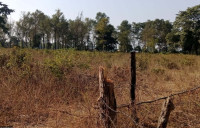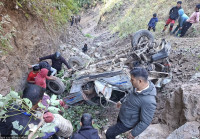National
Experts suggest following building code to lessen loss from earthquake
Nepal’s first building code was developed in 1988 following a big earthquake in Udayapur and has been revised time and again, including after the 2015 earthquake.
Post Report
Big earthquakes of 7.8 and 7.6 magnitudes hit Turkey on February 6 claiming the lives of over 46,000 and injuring thousands of others in addition to the destruction of property worth billions of dollars.
As Nepal has faced big jolts in the past and is prone to earthquakes, the experts on disaster management who coordinated in the disaster response in Turkey, said abiding by the building code strictly is very important in lessening the loss of human lives and properties.
Man Thapa, a disaster management expert, said, “We cannot avoid or stop earthquakes from occurring but can reduce its risk through different means and one of them is strictly following building codes.”
Thapa worked as a United Nations Disaster Management and Coordination member under the UN Office for the Coordination of Humanitarian Affairs in Turkey for three weeks after the earthquake.
Nepal first developed its building code in 1988 after a big earthquake in Udayapur and it has been revised time and again including after 2015’s devastating earthquake.
Thapa also suggests that a multi-disaster-prone country like Nepal needs a multi-hazard and Geographic Information System (GIS) based comprehensive risk assessment before constructing any large-scale public buildings.
“Such mapping will certainly help to know any potential future disaster risk in the areas and its possible mitigation and preparedness measures,” he said.
Thapa, who worked as a disaster management expert in different countries, presenting his findings from the Turkey earthquake in the Ministry of Home Affairs said the use of quality construction materials and construction practices too has a significant role in constructing an earthquake-resilient building. He also suggested regular monitoring of under-construction buildings to ensure the building codes have been followed.
“Regular capacity development on building code and safe building construction to individuals involved in construction related activities will certainly assist in translating the code in practice and constructing a safe building,” said Thapa.
Issues such as collective and integrated responses like accommodation, meals/foods, health, hygiene, security, water support, electricity, communication and special care, identification of major open areas, water facility, electricity supply, sewerage, health, communication, school or classroom, locally available resources, and debris management and livelihoods, and ultimately reconstruction of lives are also equally important to look after among other issues, he suggested.




 9.12°C Kathmandu
9.12°C Kathmandu














